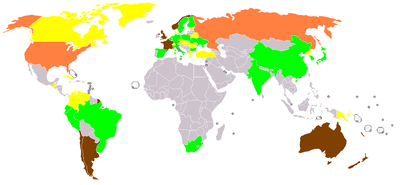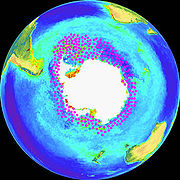
Indian Antarctic Program
Encyclopedia

Government of India
The Government of India, officially known as the Union Government, and also known as the Central Government, was established by the Constitution of India, and is the governing authority of the union of 28 states and seven union territories, collectively called the Republic of India...
. It was initiated in 1981 with the first Indian expedition to Antarctica. The program gained global acceptance with India's signing of the Antarctic Treaty
Antarctic Treaty System
The Antarctic Treaty and related agreements, collectively called the Antarctic Treaty System or ATS, regulate international relations with respect to Antarctica, Earth's only continent without a native human population. For the purposes of the treaty system, Antarctica is defined as all of the land...
and subsequent construction of the Dakshin Gangotri Antarctic research base in 1983, superseded by the Maitri
Maitri
Maitri is India's second permanent research station in Antarctica. It was built and finished in 1989, shortly before the first station Dakshin Gangotri was buried in ice and abandoned in 1990-91...
base from 1990.Under the program, atmospheric, biological, earth
Earth science
Earth science is an all-embracing term for the sciences related to the planet Earth. It is arguably a special case in planetary science, the Earth being the only known life-bearing planet. There are both reductionist and holistic approaches to Earth sciences...
, chemical
Chemistry
Chemistry is the science of matter, especially its chemical reactions, but also its composition, structure and properties. Chemistry is concerned with atoms and their interactions with other atoms, and particularly with the properties of chemical bonds....
, and medical sciences are studied by India, which has carried out 30 scientific expeditions to the Antarctic as of 14th October 2010 and is currently planning to build an additional research station in the region named Bharathi and thus India
India
India , officially the Republic of India , is a country in South Asia. It is the seventh-largest country by geographical area, the second-most populous country with over 1.2 billion people, and the most populous democracy in the world...
is all set to join the elite group of nine countries which have multiple bases in Antarctica.
History
The origins of Indian missions to the Antarctic are traced to the joint Indian Space Research OrganisationIndian Space Research Organisation
The Indian Space Research Organisation is an independent Indian governmental agency established in 1969 for the research and development of vehicles and activities for the exploration of space within and outside of Earth’s atmosphere. Headquartered in Bangalore...
– Hydrometeorological Centre of Russia
Hydrometeorological Centre of Russia
The Hydrometeorological Centre of Russia is the national meteorological service in Russia, part of the Federal Service for Hydrometeorology and Environmental Monitoring....
agreements, which led to Indians, such as Dr. Paramjit Singh Sehra, joining the 17th Soviet
Soviet Union
The Soviet Union , officially the Union of Soviet Socialist Republics , was a constitutionally socialist state that existed in Eurasia between 1922 and 1991....
Antarctic expedition of 1971–1973.
As of April 2008, India has sent a total of 27 expeditions to the Antarctic. The 27th expedition—initiated on December 6, 2007 under the National Centre for Antarctic and Ocean Research (NCAOR)—was completed on 11 April, 2008. Scientists from over 20 scientific institutions participated in this expedition, which also probed the possibility of India's third permanent research station in Antarctic.
Organization
The National Centre for Antarctic and Ocean Research—a research and developmentResearch and development
The phrase research and development , according to the Organization for Economic Co-operation and Development, refers to "creative work undertaken on a systematic basis in order to increase the stock of knowledge, including knowledge of man, culture and society, and the use of this stock of...
body functioning under the Ministry of Earth Sciences, Government of India
Government of India
The Government of India, officially known as the Union Government, and also known as the Central Government, was established by the Constitution of India, and is the governing authority of the union of 28 states and seven union territories, collectively called the Republic of India...
—controls the Indian Antarctic program. The NCAOR and the Department of Ocean Development select the members for India's Antarctic expeditions. After medical tests and subsequent acclimatization training at the Himalayas
Himalayas
The Himalaya Range or Himalaya Mountains Sanskrit: Devanagari: हिमालय, literally "abode of snow"), usually called the Himalayas or Himalaya for short, is a mountain range in Asia, separating the Indian subcontinent from the Tibetan Plateau...
, these selected members are also trained in survival, environment ethics, firefighting and operating in a group.
One expedition costs up to . Logistical support to the various activities of the Indian Antarctic program is provided by the relevant branches of the Indian armed forces
Indian Armed Forces
The Indian Armed Forces are the military forces of the Republic of India. They consist of the Army, Navy and Air Force, supported by three paramilitary forces and various inter-service institutions such as the Strategic Forces Command.The President of India is...
. The launching point of Indian expeditions has varied from Goa
Goa
Goa , a former Portuguese colony, is India's smallest state by area and the fourth smallest by population. Located in South West India in the region known as the Konkan, it is bounded by the state of Maharashtra to the north, and by Karnataka to the east and south, while the Arabian Sea forms its...
in India to Cape Town
Cape Town
Cape Town is the second-most populous city in South Africa, and the provincial capital and primate city of the Western Cape. As the seat of the National Parliament, it is also the legislative capital of the country. It forms part of the City of Cape Town metropolitan municipality...
in South Africa
South Africa
The Republic of South Africa is a country in southern Africa. Located at the southern tip of Africa, it is divided into nine provinces, with of coastline on the Atlantic and Indian oceans...
on 19th expedition during the time of NCAOR Founding Director Dr. P C Pandey in December 1999. Over 70 institutes in India contributed to its Antarctic program as of 2007.
Global Cooperation

Antarctic Treaty System
The Antarctic Treaty and related agreements, collectively called the Antarctic Treaty System or ATS, regulate international relations with respect to Antarctica, Earth's only continent without a native human population. For the purposes of the treaty system, Antarctica is defined as all of the land...
, which India signed in 1983. Pandey (2007) outlines the various international activities that India has undertaken as a part of its Antarctic program:
India also collaborates with the international community as a member of the Inter Governmental Oceanographic Commission, Regional Committee of Intergovernmental Oceanographic Commission in Coastal Indian Ocean (IOCINDIO), International Sea-Bed Authority (ISBA), and the State Parties of the United Nations Convention on the Law of the Seas (UNCLOS).
Research

Earthquake
An earthquake is the result of a sudden release of energy in the Earth's crust that creates seismic waves. The seismicity, seismism or seismic activity of an area refers to the frequency, type and size of earthquakes experienced over a period of time...
s' are among the areas of study under the Indian Antarctic program.
Close to 1,300 Indians had been to the continent as of 2001 as a part of the country's Antarctic program. Indian expeditions to the Antarctic also study the fauna and the molecular biodiversity of the region. A total of 120 new microbes had been discovered as a result of international scientific effort in the Antarctic by 2005. 20 of these microbes had been discovered by Indian scientists. India has also published over 300 research publications based on Antarctic studies as of 2007.
The 'ice cores' retrieved by drilling holes in Antarctic's vast ice-sheets yield information 'on the palaeoclimate and eco-history of the earth as records of wind-blown dust, volcanic ash
Volcanic ash
Volcanic ash consists of small tephra, which are bits of pulverized rock and glass created by volcanic eruptions, less than in diameter. There are three mechanisms of volcanic ash formation: gas release under decompression causing magmatic eruptions; thermal contraction from chilling on contact...
or radioactivity are preserved in the ice as it gets accumulated over time'. The NCAOR developed a polar research & development laboratory with a 'low-temperature laboratory complex at –20°C for preservation and analysis of ice core and snow samples' according to S.D. Gad (2008). The 'ice core' samples are held, processed, and analyzed in containment units designed by such technology. Storage cases made of poly propylene also ensure that the samples do not alter characteristics and are preserved for analysis in the form that they were recovered.
Research stations
Dakshin GangotriIn 1981 the Indian flag unfurled for the first time in Antarctica, marking the start of Southern Ocean expeditions under the environmental protocol of the Antarctic Treaty (1959). The first permanent settlement was built in 1983 and named Dakshin Gangotri. In 1989 it was abandoned after it became buried in ice.
Maitri
Maitri
Maitri is India's second permanent research station in Antarctica. It was built and finished in 1989, shortly before the first station Dakshin Gangotri was buried in ice and abandoned in 1990-91...
The second permanent settlement, Maitri, was put up in 1988–89 on the Schirmacher Oasis
Schirmacher Oasis
The Schirmacher Oasis is a 25 km long and up to 3 km wide ice-free plateau with more than 100 fresh water lakes. It is situated in the Schirmacher Hills on the Princess Astrid Coast in Queen Maud Land in East Antarctica, and is on average 100 metres above sea level...
and has been conducting experiments in geology, geography and medicine. India built a freshwater lake around Maitri known as Lake Priyadharshini. Maitri accomplished the mission of geomorphologic mapping of Schirmacher Oasis.
Bharathi (2012)
India has demarcated an area beside Larsmann Hill at 69°S, 76°E for its third settlement and second active research station. The survey has already been completed and the station is scheduled to be operational by 2012. When it is complete, India will enter the elite group of nine nations having multiple stations within the Antarctic Circle. Bharati is proposed for oceanographic research and will collect evidence of continental breakup to reveal the 120-million-year-old ancient history of the Indian subcontinent. In news sources this station is variously spelled "Bharathi", "Bharti" and "Bharati".
External links
- National Centre for Antarctic & Ocean Research (NCAOR), Ministry of Earth Sciences, Government of India.

